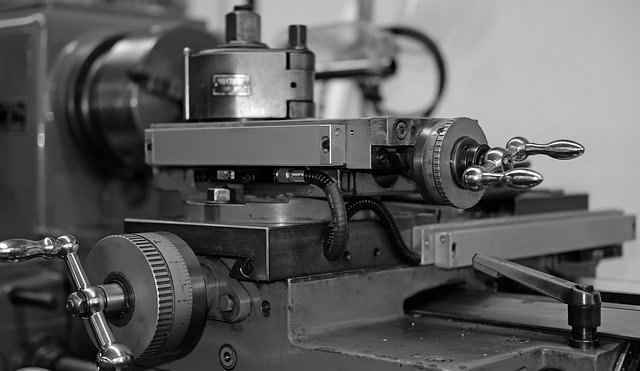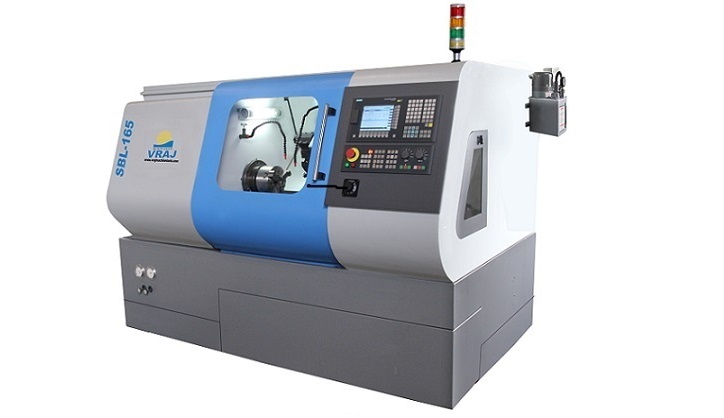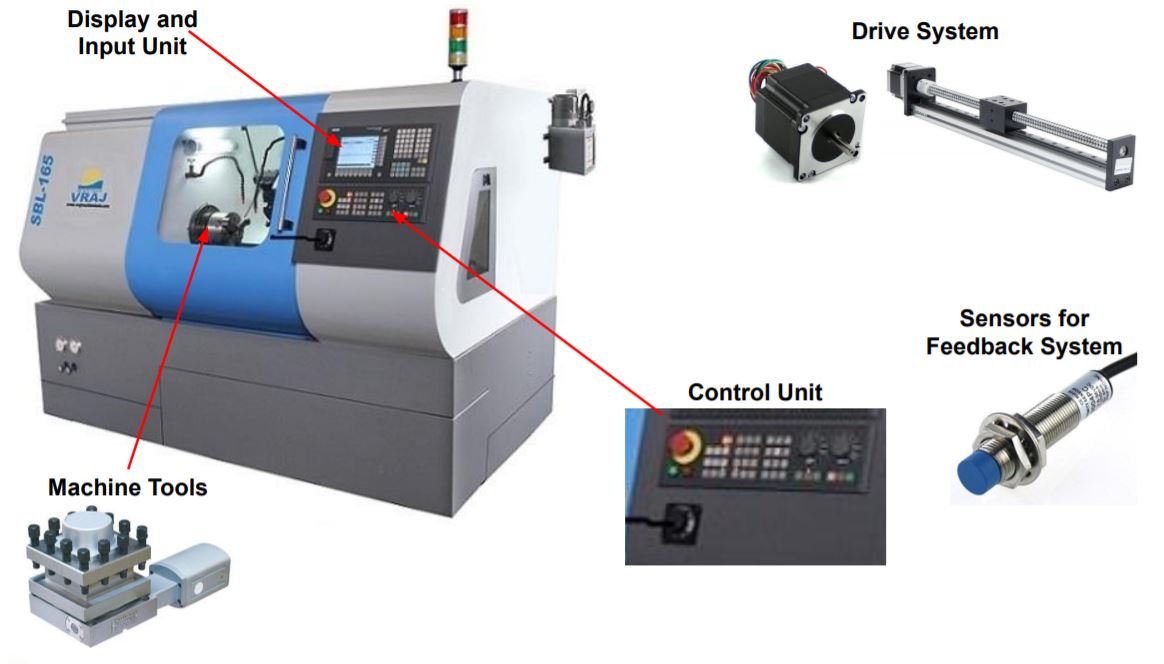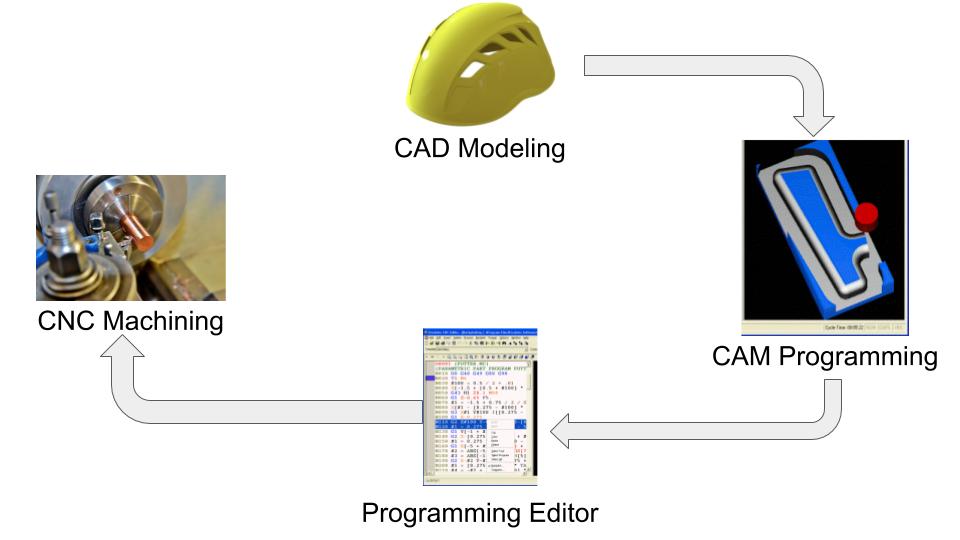What is CNC Machining?
You must have heard the name “CNC” if you are into manufacturing or engineering stuff. CNC stands for Computer Numerical Control”.
CNC Machines are automated control machines that utilize a computer program to move the cutting tool or workpiece to achieve the desired function.
In other words, during CNC machining operation, the cutting tool is moved automatically to machine parts in the required shape with minimal operator intervention. Click this link to know the best CNC Router and Desktop CNC machine for prototyping available in the market.


Major Components of a CNC Machine
A CNC machine utilizes the following components to machine parts with minimal operator intervention.
- Input and display unit
- Control unit
- Machining or cutting tools
- Feedback unit

Input and Display Unit
You can upload CNC programs into CNC machines using Floppy, pen drives, or computers. Whereas the Display unit provides machining process information to the operator. Operators can also verify input data using the display unit.
Control Unit
It is the heart of a CNC machine that controls complete machining operation. Control unit process machine program and converts them into electrical signals. These electrical signals drive various components of CNC machines.
Driving System
CNC Machine Accuracy and repeatability depend on the CNC driving system as well. The CNC driving system works according to signals received from the control unit. It can consist of the following components:
- DC and Servo Motor
- Stepper Motor
- Actuators etc.
Machine Tools
Machining tools perform desired machining tasks. Some CNC machines also come with automatic tool changer units. In these machines, there is no need to change the machining tool manually.
Feedback Unit
The feedback unit ensures the machine executes the given instructions. It consists of positioning and feedback sensors to monitor the position of cutting tools.
Why do We need CNC Machining?
Conventional machines are controlled manually by the operator. The operator has to move the cutting tool and workpiece manually for machining. As a result, manufactured part quality and productivity become dependent on the operator’s skills.
CNC machining operation is preferred over conventional machining to increase productivity and improve manufactured part quality. Because In CNC machining, the operator’s job is to load and unload parts.
The cutting tool and workpiece are moved automatically according to the CNC program. Once the CNC program is ready, CNC machines can machine multiple parts with minimal operator intervention.
How Does a CNC Machine Works?
CNC machines use digital instructions (such as G-Code or M-Codes) to move and tool and workpiece in a CNC machine. For machining, the Operator firstly loads digital instructions (CNC Program) and fixes the workpiece in the machine. Afterward, machines perform required machining operations automatically with minimal operator interference.

Generally, the machining process requires multiple tools to achieve the required machining operation. More advanced CNC machines come with automatic tool changers as well. An automatic tool changer eliminates the need to manually changing the tool.
3-axis CNC machines can machine the workpiece in two directions only. Therefore to machine part on the bottom face, the operator has to flip the workpiece.
Whereas in a multi-axis machine, the machine can flip the parts for machining the bottom face. Therefore the need for the operator to flip part is eliminated.
Types of CNC Machines
Any machine that can move tool head and workpiece automatically is known CNC machine. Different types of CNC machines have different cutting tools and tool or workpiece motion in different directions.
Therefore any machine that utilizes digital codes to move a workpiece or tool is a CNC Machine.
For example, even a 3D printer is a type of CNC because it utilizes machine codes to print parts automatically. But It is not exactly a CNC machine.
Types of CNC Machines according to Operation they Perform
The following types of CNC machines are available according to the type of machining operation they perform:
- CNC Lathe.
- CNC Milling Machine.
- Plasma and Laser cutter CNC.
- CNC Liquid Gasket Dispensing.
- CNC Router.
- Sheet Metal Punching Press.
- EDM and Wire Cut CNC.
- Press brakes for sheet metal Bending etc.
Applications of CNC Machining Operation
Nowadays, CNC machines are replacing conventional machines because they reduce the dependency of the machine operator. Here are the widely used applications of CNC machining operation:
- To machine complex parts with close tolerance and repeatability such as engine block, nozzle, jig fixtures, etc.
- Automating the manufacturing process reduces operator dependency.
- Machine low production volume parts. For example, the manufacturing cost for jigs and fixtures for conventional machines can be more than the total part manufacturing cost.
- Improve machined part quality.
- Machine operators can not machine Complex 3D surfaces manually. Therefore manufacturer recommends CNC machining for complex contours and 3D surfaces.
- CNC machining is an alternative to 3D printing for Plastic Prototyping.
Advantages of CNC Machines Over Conventional Machines
CNC machining process has the following advantages compared to the conventional machining process:
- Improved machining accuracy.
- Repeatability in manufactured parts.
- Complex geometries can be machined.
- High productivity because of reduced setup and changeover time.
- Low manufacturing cost for large quantities.
- Reduced labor cost.
- Manufacturing automation is possible.
Disadvantages of CNC Machining
CNC machining has the following disadvantages:
- High Initial Investment.
- Machining simple parts using CNC machines can be more costly.
- High maintenance cost.
- CNC programming Skill Required: Sometimes outsourcing CNC programming can be costly.
- Need CAD model of the part to be machined. Without the cad model, CNC programming is very difficult or not possible at all.
We will keep updating more information on what is CNC machine? it’s working and applications. Add your comments or questions in the comment box. We suggest you read this article on the difference between drilling boring and reaming.

Add a Comment